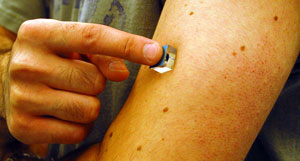| Posted: September 1, 2010 |
New pump created for microneedle drug-delivery patch |
|
(Nanowerk News) Purdue University researchers have developed a new type of pump for drug-delivery patches that might use arrays of "microneedles" to deliver a wider range of medications than now possible with conventional patches.
|
|
The current "transdermal" patches are limited to delivering drugs that, like nicotine, are made of small hydrophobic molecules that can be absorbed through the skin, said Babak Ziaie, a professor of electrical and computer engineering and biomedical engineering.
|
|
"There are only a handful of drugs that currently can be administered with patches," he said. "Most new drugs are large molecules that won't go through the skin. And a lot of drugs, such as those for treating cancer and autoimmune disorders, you can't take orally because they aren't absorbed into the blood system through the digestive tract."
|
 |
| Purdue doctoral student Charilaos Mousoulis demonstrates a prototype pump for drug-delivery patches that might use arrays of microneedles to deliver a wider range of medications than now possible with conventional patches.
|
|
Patches that used arrays of tiny microneedles could deliver a multitude of drugs, and the needles do not cause pain because they barely penetrate the skin, he said.
|
|
"It's like a bandage - you would use it and discard," Ziaie said.
|
|
The patches require a pump to push the drugs through the narrow needles, which have a diameter of about 20 microns, or roughly one-fourth as wide as a human hair. However, pumps on the market are too complex for patches, he said.
|
|
"We have developed a simple pump that's activated by touch from the heat of your finger and requires no battery," Ziaie said.
|
|
The pump contains a liquid that boils at body temperature so that the heat from a finger's touch causes it to rapidly turn to a vapor, exerting enough pressure to force drugs through the microneedles.
|
|
"It takes 20 to 30 seconds," Ziaie said.
|
|
The liquid is contained in a pouch separated from the drug by a thin membrane made of a rubberlike polymer, called polydimethylsiloxane, which is used as diaphragms in pumps.
|
|
Research findings are detailed in a paper ("A Skin-Contact-Actuated Dispenser/Pump for Transdermal Drug Delivery") being presented during the 14th International Conference on Miniaturized Systems for Chemistry and Life Sciences on Oct. 3-7 at University of Groningen in The Netherlands. The paper was written by electrical and computer engineering doctoral students Charilaos Mousoulis and Manuel Ochoa and Ziaie.
|
|
Researchers have filed an application for a provisional patent on the device.
|
|
Ziaie has tested prototypes with liquids called fluorocarbons, which are used as refrigerants and also in semiconductor manufacturing.
|
|
"You need a relatively large force, a few pounds per square inch, to push medications through the microneedles and into the skin," Ziaie said. "It's very difficult to find a miniature pump that can provide that much force."
|
|
Findings indicate prototypes using the fluorocarbon HFE-7000 exerted 4.87 psi and another fluorocarbon, FC-3284, exerted 2.24 psi.
|
|
The work has been supported with funding from the National Science Foundation. Future research may include work to try the pump with microneedles.
|

